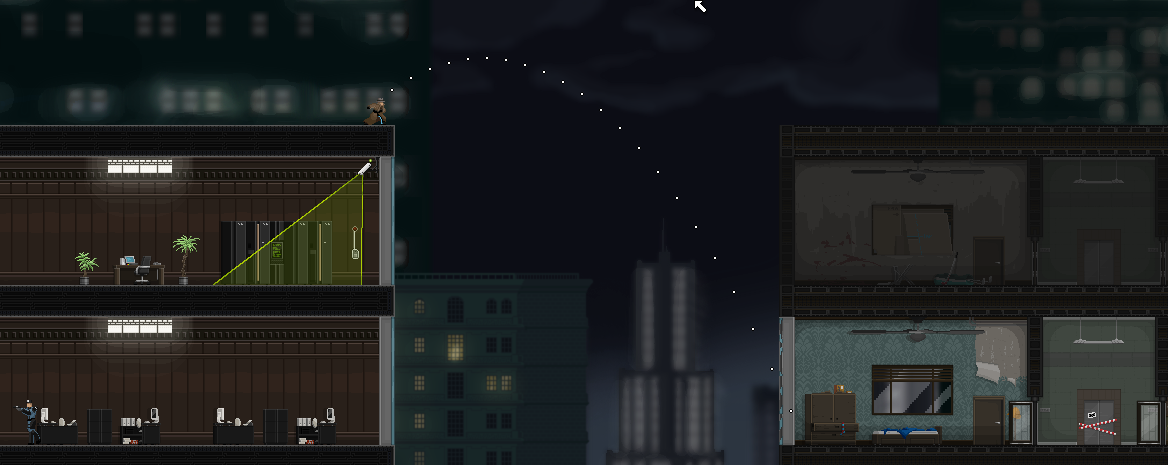TOM FRANCIS
REGRETS THIS ALREADY
Hello! I'm Tom. I'm a game designer, writer, and programmer on Gunpoint, Heat Signature, and Tactical Breach Wizards. Here's some more info on all the games I've worked on, here are the videos I make on YouTube, and here are two short stories I wrote for the Machine of Death collections.
Theme
By me. Uses Adaptive Images by Matt Wilcox.
Search
Top 100 Musings #1: Battlefield 2

With four people in a room, on the same team on an empty map, throwing themselves from one flying vehicle to the next, Battlefield 2 is the most fun you can have without drugs. But how much does that count towards its greatness as a game, given that you’re not really playing the game?
Too Zune
My MP3 player has finally, inevitably broken beyond repair. It’s stuck on record, it won’t stop recording everything, so it’s just what you want lying around the White House Counsel’s office. And in an odd twist, Apple’s recent MP3-player announcements were more appealing than Microsoft’s. I say odd because Microsoft and Apple are sort of like Churchill and Hitler to me: I wouldn’t want to hang out with either of them, but there’s “not nice” and then there’s the holocaust. I could never buy either, but I really like that Apple have made each of their models dramatically better in at least three ways each, and reduced the price. I always like it when a company goes further than strictly necessary to maximise sales.

Microsoft’s MP3 player, apart from looking like a seventies TV set (update! Or a complicated biscuit, as Tom puts it), is a festering hive of digital rights-management restrictions. It has the cool-sounding ability to wirelessly share tracks with other Zunes (sans PC), but restricts the sharee to three listens of the track before it’s deleted. To do that, it actually infects your music with its DRM chastity belt, even if it’s an MP3 you recorded your damn self. Having grown up with computers, I’m afraid I’m one of these techno-hippies who regard data as sacred. It seems fine to me to offer services like iTunes where you buy music with restrictions built in, but my stuff is sacrosanct. Your seventies TV has no idea what it is, where it came from and what I’m entitled to do with it.

So I somehow found room to be offended by that even though I didn’t want the feature and knew I wouldn’t buy one anyway. The core reason I can’t use a Zune or iPod is that both insist on their own evil infection of your machine. iTunes is the reason I don’t flinch when comparing Apple’s products to the holocaust. The Zune, like anything that wants to support Microsoft’s DRM stuff, uses the Media Transfer Protocol to talk to your PC. That means it isn’t a storage device you’re free to use as you please; everything you transfer to it has to go through Windows Media Player 10. This is disastrously unreliable, slow and restrictive. MTP will actually stop you from copying a file type that Windows Media Player doesn’t recognise to your player, even if the player itself specifically supports it. MTP devices show up in Explorer, and are mocked up to look like storage drives, but you’re restricted to the default view, your right-click options are taken away, and you can’t open files directly from the device. Explorer is about the only part of Windows that still almost works intuitively, though XP tried its level best to obfuscate it and mollycoddle new users into misunderstanding their system, and they’ve specifically crippled it to be less logical and usable with respect to MP3 players. I will enjoy watching you fail, Microsoft, even if it is to a greater evil.
Some brands pointedly boycott MTP, or at least pointedly include a UMS option – USB Mass Storage, an older protocol from the days when things were built to work rather than monitor and defy you. Sandisk’s Sansa players have had an aggressively anti-iPod campaign, and bragged about their ‘just works’ driverless storage device functionality, but they do lose marks for also supporting MTP as an alternate mode (“I’m clean, but also support herpes as an alternate mode”) and only supporting video in Quicktime format. Their contempt for Apple’s proprietry restrictiveness would ring truer if they hadn’t co-opted Apple’s own grossly inefficient, poor-quality, bloated, slow and disgusting QuickTime format. More admirably but more cumbersomely, bovine-sounding Cowon make UMS-only players, proudly support OGG (an open-source music format, more efficient than MP3), and have a ridiculous 35-hour battery life on their larger model. My favourite musical gadget site Anything But iPod specialise in alternatives, and are good about specifying MTP or UMS in their reviews. My hope is that Microsoft having their own player to pimp will mean they stop putting pressure on once-cool companies like iRiver and Creative to cripple their players with MSDRM-friendly FFS-inducing MTP, and that Anything But Zune launches soon.
Tom’s Tstretch Timer
I could never find a work/break timer that worked quite how I wanted, so I made my own. Lately, though, I’ve had RSI issues, and now my focus is on just ensuring I don’t work too long without taking a break to stretch. My old timer half-worked for that, but to get really consistent, I needed something that:
- Tracked whether I was using my PC or not automatically, without needing to remember to press a button.
- Let me configure the maximum time I’m allowed to work, and how long I have to take a break before it counts as a break.
- When I overwork, nag me in (customisable) ways that are gentle enough I won’t just close the app, but persistent enough I won’t just ignore it.
- Met or exceeded the high standards of alliteration established by Tom’s Timer.
And so!
Tom’s Tstretch Timer
(Windows, 17MB, v1.6)

“Every moment of my life it haunts me. I work. I eat. I rest. I sleep. Still it persists. Tom’s Tstretch Timer 1.4.”
Victoria Tran, referring to a previous version.
“Repeatedly” means once a minute, and it stops nagging if you’ve been AFK 30 secs already. You don’t have to click Reset to resume working, that’s just for the GIF. You can force Work or Break mode with those buttons, but generally just leaving it in Auto mode is best.
Tom’s Timer 5
8 years ago I made a little timer app to sit in my taskbar and track how long I’d worked or not-worked. I’ve used it pretty regularly ever since, and every now and then my need for some extra feature or tweak outweighs my laziness and I make a new version. I’ve just made v5. Continued
Tom And Nika Vs The Necromancers Of Monaco, Parts 1-5
I’ve been playing Monaco co-op with Nika, and we’re YouTubing the whole fiasco. We’re up to Part 5 now, click the listy button in the top left to skip to an episode.
I struggled to get into Monaco when it first came out: I found it visually confusing, and most of the classes seemed bad. But over the course of these videos it starts to really click, and at its best it’s a hilarious, calamitous caper.

To Hell And Back In Spelunky
Last night I accomplished probably the hardest thing I’ve ever managed in a video game: going to hell and back in Spelunky. It only took 41 minutes, but it took me hundreds of hours of play – and about 3,000 deaths – to learn how to do those 41 minutes. Here’s the run: Continued

Tiny Design
Tiny Design is a good blog about tiny design choices and why they were (probably) made. A lot of them are things you might not consciously notice, which made me think that there may be others you still haven’t consciously noticed. So here’s one you might not have noticed in Gunpoint! Unless you followed its development, because I tweeted about it 5 years ago. Continued
Thoughts On The Team Fortress 2 Christmas Changes

Disclaimer: this expression does not faithfully represent my feelings on these changes.
Left 4 Dead has ceased to be a regular fixture in my schedule, but it somehow made TF2 feel old, or overfamiliar. So I’m mega-, perhaps even ultra-pleased with the timing of the pretty dramatic overhaul that just went live.
Also, Scout update is next, thank God. I was wrong about the Spy hint in the previous TF2 blog post title. I asked Robin about it a while back – he was amused by the extreme scrutiny speculators subjected his wording to. He just has the TF2 script doc open and selects a line at random.
- The Engineer’s teleporters can now be upgraded to level three. It will recharge faster the higher level it is
Great news. They pretty much confirmed this ages ago, but it wasn’t clear if they’d work it into the Engy pack or release it as a separate tweak. It seems like this has to add more variety to viable engy tactics, and just as importantly, more variety to the litany of complaints we can level against our Engies when they inevitably ignore this new ability and hunker down behind their ill-positioned Sentry.
- The Engineer’s dispensers can now be upgraded to level three. It will give out metal and heal faster as it is upgraded
Yay. But I’m guessing this still means placing it right behind you and your Sentry is still the only logical position. One of the main Engy changes I’d like to see is making it viable to place your dispenser where your team most needs it without crippling your own ability to keep yourself and your Sentry alive.
- Spies will be able to recharge their cloaking ability by picking up ammo off of the ground or from health cabinets
The health cabinets thing has been suggested three times a day since the dawn of time, though I can’t say I’ve ever wanted it. When I run out of Cloak, I’m in the enemy base. Because I used my Cloak. You know, to get past enemies. Gobbling up ammo to replenish it is much more interesting to me, because it means less waiting around without encouraging me to walk all the way back to base.
- Some changes to the second part of the first stage of Goldrush to give the attackers more of an advantage
Okay, but I can’t say this is the stage that usually gives me trouble as an attacker. It’s always, always stage 2 cap 2, and trying to assault a good defense of that point is the most miserably futile experience you can have with TF2.
- Any weapons that fire bullets (shotguns, sniper’s machine gun, heavy’s minigun, etc.) can now break apart the Demoman’s stickybombs
Wow, okay, yes. Anything that’s bad for Demomen is fine by me, even when I’m playing Demoman. I didn’t expect them to do this particular nerf, though. One of the few things I like about Demomen right now is they don’t over-abuse their ability to place stickies where it’s impossible to see them before they kill you – more often they use them out in the open for area denial, warning people off a cap. If everyone can destroy them now, I’m a little worried that Demomen are going to learn to always put them in hidden places, and I’ve never discovered any way to anticipate or counter that tactic. Even if you’re looking in exactly the right direction as you round a corner, you’re surely not going to be able to destroy them all before the Demoman can right-click to kill you.
- The icon on the HUD for a person calling for Medic will now give more information to the medic (if the target is low on health, on fire, etc.)
At freaking last! This seemed like such an obvious thing, I thought there must be some complicated technical reason why they didn’t do it in the first place.
- Added an achievement tracker that will allow people to choose specific achievements that they are trying to get
omg tf2=wow ffs valve gay ferrets tldr. Actually this’ll be quite useful. But I’m still not doing most of those Medic ones.
- There is now a custom icon for death messages when the player was killed from a critical hit
GOOD. Now the world shall see that not only am I killed by a critical hit every time I die, but it’s always in a situation and with an amount of health that would guarantee I survive an equivalent non-critical hit and Valve will realise their game is entirely random, sob for a little while, then remove crits forever and issue a public apology. (Hey guys, let’s get into a discussion about whether crits are a good thing.)
- Added a new particle effect for when a player enters the water
+5% to review score.
- Added smoke to the feet of a rocket jumping soldier
+10% to review score.
- Players will now have some particles swirling around them so other players can see when they are overhealed
I heartily endorse this. I think everything mechanically important should be visually apparent (except Cloaked Spies). Now they just need a way to show how hurt players are.
- Attempts by player Pentadact to connect to any servers now result in immediate timeouts, ensuring he can no longer play the game at all
This is the only one I’m not crazy about. I realise I’m inevitably biased, but it just seems unlike Valve to make such a specific tweak. And personally, it’s starting to diminish my enjoyment of the game.
Thoughts On The First Deus Ex: Mankind Divided Trailer
There’s a new Deus Ex game coming, and there’s a trailer for it! It was all we could talk about last night on the podcast, until we’d covered it and moved on (about 32 minutes) to talk about other things. Listen to know my, and their, thoughts!
Thoughts On Neon Struct
In the new podcast I discuss what I thought of Neon Struct, a retro first-person stealth game by Eldritch creator David Pittman, with very conscious nods to Deus Ex and Thief. Here is the part where I do that!
I didn’t like it at first but then I did. A few people have asked if I’ll do a Let’s Play: I tried, but as you’ll hear, level 1 did not go well and took a very long time, so I stopped. Steve Gaynor’s playthrough here is much how mine went: we both tried the same thing and had the same problems.
Thoughts On Invisible Inc And GalCiv 3
Both these games are out now, and I’ve played them both, and I say what I think of them both on the new Crate & Crowbar podcast! This embed starts when Tom Senior and I trading Invisible Inc tales (his voice first), then I get to the ridiculous way I handled the GalCiv 3 tutorial at 1:00:05.
Thoughts On Far Cry 4
If you’ve been following my many Far Cry 4 videos over on YouTube you already have an idea of what I love about it, but if you’re interested, here’s the bit of the latest Crate & Crowbar podcast where we compare our impressions. I’m not the first Tom who speaks, I’m the one saying “I think it got off to a pretty shaky start”.
Don’t let me forget that I plan to do a ‘How to fix Far Cry 4’ type post at some point, too.
Thoughts On Fallout 4 And Invisible Inc’s Contingency Plan
On the latest two Crate and Crowbar podcasts I talk about what I’ve been up to in these two games, and what I think of them. Here are the bits where I do that, Fallout first! Continued
Thoughts On Dragon Age: Inquisition
We discuss DA:I on the latest Crate and Crowbar podcast, and since it’s also up on YouTube, I can embed specific bits. The Invisible Inc chat at the start overlaps a lot with my post here, so let’s skip straight to Dragon Age, which I played for about 30-40 hours over the break.
I have thoughts on why the combat still feels murky after all this time, my experience switching from Casual to Hard, my lesbian Inquisitor trying to seduce the only two straight women in Thedas, the difference between this and Mass Effect, and the one great thing that’s the same.
As before it’s Tom Senior you hear first, I’m the one who pipes up at 44m55s.

Thoughts About Praise And Confidence At GDC And Rezzed
I’ve just got back from sixteen days of travelling: first to the Game Developers’ Conference in San Francisco, then to the indie game show Rezzed in London. I was showing Heat Signature to the press at GDC and to the public at Rezzed, but events like these are also huge meetups for a bunch of geographically separated friends – and people who are very likely to become that. So it’s been more pleasure than business, and the evenings have been as hectic as the days. Continued